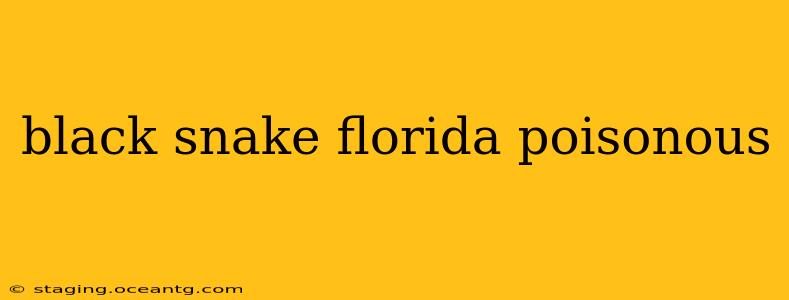Florida boasts a diverse array of snake species, and many are black or predominantly dark-colored. This often leads to confusion and concern, particularly regarding venomous snakes. So, are black snakes in Florida poisonous? The short answer is: it depends. Not all black snakes in Florida are venomous, and correctly identifying the species is crucial for safety.
What Types of Black Snakes Live in Florida?
Several non-venomous and venomous snakes in Florida exhibit black or dark coloration. Let's examine some of the most common:
-
Black Rat Snake ( Pantherophis obsoletus): This is a large, non-venomous snake frequently found throughout Florida. They are often entirely black, but can also exhibit variations with grey or brown markings. They are excellent climbers and often found in trees.
-
Black Racer ( Coluber constrictor priapus): Another non-venomous species, the black racer is known for its speed and sleek, black body. They are typically found in open areas and are active during the day.
-
Eastern Indigo Snake ( Drymarchon couperi): This large, non-venomous snake is mostly black but can have hints of blue or purple. It is a threatened species, and encounters are relatively rare.
-
Eastern Diamondback Rattlesnake ( Crotalus adamanteus): While adults can sometimes appear almost entirely black, this is a highly venomous pit viper. The key identifier is the presence of the characteristic rattles on their tail.
-
Cottonmouth ( Agkistrodon piscivorus): Although usually brown or dark brown, some cottonmouths can be nearly black. These are venomous snakes with distinctive features, including a wide head and dark mouth lining visible when threatened.
Are Black Snakes in Florida Always Venomous?
No, black snakes in Florida are not always venomous. Many species are harmless and play a beneficial role in the ecosystem by controlling rodent populations. However, the presence of venomous black snakes like the Eastern Diamondback Rattlesnake and the Cottonmouth necessitates caution.
How to Identify Venomous Black Snakes in Florida
Accurately identifying a snake is critical to determining its venom status. Instead of relying solely on color, focus on these characteristics:
-
Rattles: The presence of a rattle is a definitive indicator of a rattlesnake, a venomous species.
-
Head Shape: Venomous snakes like cottonmouths and rattlesnakes often have triangular-shaped heads, distinctly wider than their necks.
-
Pupil Shape: Most venomous snakes in Florida have elliptical or cat-like pupils, whereas many non-venomous snakes have round pupils.
-
Body Shape: Note the snake's overall body shape and thickness. Some venomous snakes have a thicker, heavier body compared to similarly sized non-venomous snakes.
-
Heat-Sensing Pits: Venomous pit vipers, including cottonmouths and rattlesnakes, possess heat-sensing pits located between their eyes and nostrils.
What Should I Do If I Encounter a Black Snake in Florida?
- Maintain a Safe Distance: Avoid approaching or handling any snake, regardless of its color.
- Identify the Snake (if possible): Try to observe the snake from a safe distance, noting its features to help with identification.
- Contact Wildlife Professionals: If you are uncertain about the snake's identity or feel threatened, contact a local wildlife removal service or your state's wildlife agency.
Can a Black Snake Bite Kill You in Florida?
While some black snakes in Florida are venomous, a bite is not always fatal. However, venomous snake bites require immediate medical attention. The severity of a bite depends on factors such as the species of snake, the amount of venom injected, and the victim's health condition.
What is the most common black snake in Florida?
The Black Rat Snake and the Black Racer are among the most commonly encountered black snakes in Florida. Both are non-venomous.
Remember, preventing snake bites starts with responsible behavior and awareness. By understanding the diversity of Florida's black snakes and knowing how to identify venomous species, you can significantly reduce your risk of encountering a dangerous situation. Always err on the side of caution and respect wildlife.
